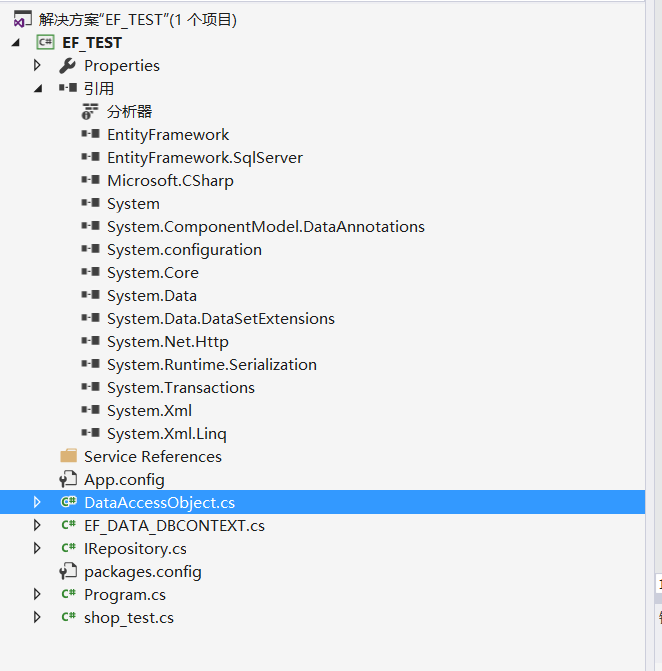EF分为三种code_first,model_first,dabase_first这三种模式,网上的例子有好多,但是用了之后感觉实际中都不是这么用的,此处记录写下来日后用的着了可以快速应用,记录如下:
新建项目添加EF6.2
需要四个东西:
1.表对应的model实例,此例中为: shop_test
2.EF连接数据的对象类,此例中为: EF_DATA_DBCONTEXT
3.数据操作的接口类,此例中为: IRepository
4.数据实际操作类,实现接口IRespository的类,此例中为: DataAccessObject

1.shop_test
using System;
using System.Collections.Generic;
using System.Linq;
using System.Text;
using System.Threading.Tasks;
using System.ComponentModel.DataAnnotations.Schema;
using System.ComponentModel.DataAnnotations;
using System.Runtime.Serialization;
namespace EF_TEST
{
[DataContract]
[Serializable]
[Table("shop_test")]
public partial class shop_test
{
[DataMember(Name ="id")]
[Key]
[DatabaseGenerated(DatabaseGeneratedOption.Identity)]
public int id { get; set; }
[DataMember(Name ="shopname")]
public string shopname { get; set; }
[DataMember(Name ="create_time")]
public DateTime create_time { get; set; }
[DataMember(Name ="test_msg")]
public string test_msg { get; set; }
}
}
2.EF_DATA_DBCONTEXT
using System;
using System.Collections.Generic;
using System.Linq;
using System.Text;
using System.Threading.Tasks;
using System.Data.Entity;
namespace EF_TEST
{
//用EF进行连接时需要指定的连接数据库的
class EF_DATA_DBCONTEXT:DbContext
{
public EF_DATA_DBCONTEXT(string contr) : base(contr)
{
}
protected override void OnModelCreating(DbModelBuilder modelBuilder)
{
//base.OnModelCreating(modelBuilder);
}
public DbSet<shop_test> shoptests { get; set; }
}
}
3.IRepository
using System;
using System.Collections.Generic;
using System.Linq;
using System.Text;
using System.Threading.Tasks;
using System.Linq.Expressions;
using System.Data.Entity;
using System.Data.Entity.Infrastructure;
namespace EF_TEST
{
interface IRepository
{
DbContext CurrentDbContext
{
get;
}
DbEntityEntry<T> Attach<T>(T entity) where T : class;
T Insert<T>(T entity) where T : class;
T Insert<T>(T entity, bool isCommit) where T : class;
void InsertRange<T>(IEnumerable<T> entities) where T : class;
void InsertRange<T>(IEnumerable<T> entities, bool isCommit) where T : class;
void Update<T>(T entity) where T : class;
void Update<T>(T entity, bool isCommit) where T : class;
void UpdateRange<T>(IEnumerable<T> entities) where T : class;
void UpdateRange<T>(IEnumerable<T> entities, bool isCommit) where T : class;
void Delete<T>(T entity) where T : class;
void Delete<T>(T entity, bool isCommit) where T : class;
void DeleteRange<T>(IEnumerable<T> entities) where T : class;
void DeleteRange<T>(IEnumerable<T> entities, bool isCommit) where T : class;
T Find<T>(params object[] keyValues) where T : class;
T Find<T>(object keyValue) where T : class;
List<T> FindAll<T>(Expression<Func<T, bool>> conditions = null) where T : class;
List<T> FindAllByPage<T, S>(Expression<Func<T, bool>> conditions, Expression<Func<T, S>> orderBy, int pageSize, int pageIndex) where T : class;
int SaveChanges();
}
}
4.DataAccessObject
using System;
using System.Collections.Generic;
using System.Linq;
using System.Text;
using System.Threading.Tasks;
using System.Data.Entity;
using System.Linq.Expressions;
using System.Data.Entity.Infrastructure;
using System.Data;
namespace EF_TEST
{
class DataAccessObject:IRepository,IDisposable
{
private DbContext _currentDbContext = null;
public DbContext CurrentDbContext
{
get
{
return this._currentDbContext;
}
}
public DataAccessObject(DbContext dbContext)
{
this._currentDbContext = dbContext;
}
public DbEntityEntry<T> Attach<T>(T entity) where T : class
{
DbSet<T> dbSet = this._currentDbContext.Set<T>();
dbSet.Attach(entity);
return this._currentDbContext.Entry<T>(entity);
}
public T Insert<T>(T entity) where T : class
{
return this.Insert<T>(entity, true);
}
public T Insert<T>(T entity, bool isCommit) where T : class
{
this._currentDbContext.Set<T>().Add(entity);
if (isCommit)
{
this._currentDbContext.SaveChanges();
}
return entity;
}
public void InsertRange<T>(IEnumerable<T> entities) where T : class
{
this.InsertRange<T>(entities, true);
}
public void InsertRange<T>(IEnumerable<T> entities, bool isCommit) where T : class
{
this._currentDbContext.Set<T>().AddRange(entities);
if (isCommit)
{
this._currentDbContext.SaveChanges();
}
}
public void Update<T>(T entity) where T : class
{
this.Update<T>(entity, true);
}
public void Update<T>(T entity, bool isCommit) where T : class
{
this._currentDbContext.Set<T>().Attach(entity);
//this._currentDbContext.Entry<T>(entity).set_State(16);
this._currentDbContext.Entry<T>(entity).State = EntityState.Modified;
if (isCommit)
{
this._currentDbContext.SaveChanges();
}
}
public void UpdateRange<T>(IEnumerable<T> entities) where T : class
{
this.UpdateRange<T>(entities, true);
}
public void UpdateRange<T>(IEnumerable<T> entities, bool isCommit) where T : class
{
foreach (T current in entities)
{
this._currentDbContext.Set<T>().Attach(current);
// this._currentDbContext.Entry<T>(current).set_State(16);
this._currentDbContext.Entry<T>(current).State = EntityState.Modified;
}
if (isCommit)
{
this._currentDbContext.SaveChanges();
}
}
public void Delete<T>(T entity) where T : class
{
this.Delete<T>(entity, true);
}
public void Delete<T>(T entity, bool isCommit) where T : class
{
this._currentDbContext.Set<T>().Remove(entity);
if (isCommit)
{
this._currentDbContext.SaveChanges();
}
}
public void DeleteRange<T>(IEnumerable<T> entities) where T : class
{
this.DeleteRange<T>(entities, true);
}
public void DeleteRange<T>(IEnumerable<T> entities, bool isCommit) where T : class
{
this._currentDbContext.Set<T>().RemoveRange(entities);
if (isCommit)
{
this._currentDbContext.SaveChanges();
}
}
public int SaveChanges()
{
return this._currentDbContext.SaveChanges();
}
public T Find<T>(params object[] keyValues) where T : class
{
return this._currentDbContext.Set<T>().Find(keyValues);
}
public T Find<T>(object keyValue) where T : class
{
object[] array = new object[]
{
keyValue
};
return this._currentDbContext.Set<T>().Find(array);
}
public List<T> FindAll<T>(Expression<Func<T, bool>> conditions = null) where T : class
{
List<T> result;
if (conditions == null)
{
result = this._currentDbContext.Set<T>().ToList<T>();
}
else
{
result = this._currentDbContext.Set<T>().Where(conditions).ToList<T>();
}
return result;
}
public List<T> FindAllByPage<T, S>(Expression<Func<T, bool>> conditions, Expression<Func<T, S>> orderBy, int pageSize, int pageIndex) where T : class
{
IQueryable<T> source = (conditions == null) ? this._currentDbContext.Set<T>() : this._currentDbContext.Set<T>().Where(conditions);
return source.OrderByDescending(orderBy).Skip((pageIndex - 1) * pageSize).Take(pageSize).ToList<T>();
}
public void Dispose()
{
this._currentDbContext.Dispose();
}
}
}
控制台程序:
using System;
using System.Collections.Generic;
using System.Linq;
using System.Text;
using System.Threading.Tasks;
using System.Data.Entity;
using System.Transactions;
namespace EF_TEST
{
class Program
{
static void Main(string[] args)
{
//config中的数据库的连接字符串
string CONSTR = System.Configuration.ConfigurationManager.ConnectionStrings["CONSTR"].ConnectionString;
//EF的DB连接对象
EF_DATA_DBCONTEXT db = new EF_DATA_DBCONTEXT(CONSTR);
//实现的的具体方法
IRepository DB_LINK = new DataAccessObject(db);
//进行的查询操作
List<shop_test> msg = DB_LINK.FindAll<shop_test>(p => p.id >= 0);
Console.WriteLine("查询ID大于0的所有数据");
Console.WriteLine("共查询到的信息行数:{0}--最后一个数据的时间:{1}", msg.Count, msg.Max(u => u.create_time).ToString());
//插入操作
shop_test insert_shop = new shop_test() { shopname="test", test_msg="ss", create_time =DateTime.Now };
using (TransactionScope scope =new TransactionScope() )
{
DB_LINK.Insert<shop_test>(insert_shop,false);
shop_test insert_second = new shop_test() { shopname=insert_shop.shopname, test_msg=insert_shop.test_msg, create_time=DateTime.Now };
DB_LINK.Insert<shop_test>(insert_second, false);
DB_LINK.SaveChanges();
scope.Complete();
}
Console.WriteLine("插入的id:{0}--shopname {1}---test_msg:{2} ---create_time:{2}", insert_shop.id, insert_shop.shopname, insert_shop.test_msg, insert_shop.create_time);
//更新操作
msg = DB_LINK.FindAll<shop_test>(u => u.id > 0);
Console.WriteLine("查询ID大于0的所有数据");
Console.WriteLine("共查询到的信息行数:{0}--最后一个数据的时间:{1}", msg.Count, msg.Max(u => u.create_time));
//更新操作,更新最大时间为当前时间
shop_test update_shop = (from i in msg
let max_time = msg.Max(u => u.create_time)
where i.create_time == max_time
select i
).FirstOrDefault();
update_shop.create_time = DateTime.Now;
DB_LINK.Update<shop_test>(update_shop);
Console.WriteLine("更新的id:{0}--shopname {1}---test_msg:{2} ---create_time:{2}", insert_shop.id, insert_shop.shopname, insert_shop.test_msg, insert_shop.create_time);
//删除操作;
Console.WriteLine("查询ID大于0的所有数据");
Console.WriteLine("共查询到的信息行数:{0}--最后一个数据的时间:{1}", msg.Count, msg.Max(u => u.create_time));
//删除操作 删除时间最早的数据
msg = DB_LINK.FindAll<shop_test>(u => u.id > 0);
shop_test delete_shop = (from i in msg
let max_time = msg.Max(u => u.create_time)
where i.create_time == max_time
select i
).FirstOrDefault();
DB_LINK.Delete<shop_test>(delete_shop);
Console.WriteLine("删除的id:{0}--shopname {1}---test_msg:{2} ---create_time:{2}", insert_shop.id, insert_shop.shopname, insert_shop.test_msg, insert_shop.create_time);
Console.WriteLine("查询ID大于0的所有数据");
Console.WriteLine("共查询到的信息行数:{0}--最后一个数据的时间:{1}", msg.Count, msg.Max(u=>u.create_time));
Console.ReadKey();
}
}
}
配置文件,及其数据库的表结构:
<connectionStrings>
<!--<add name="CONSTR" connectionString="DATA SOURCE=127.0.0.1;INITIAL CATALOG=TEST;USER ID=SA;PASSWORD=123"/>-->
<add name="CONSTR" connectionString="Data Source=127.0.0.1;Database=TEST;UID=sa;PWD=123;" providerName="System.Data.SqlClient"/>
</connectionStrings>
CREATE TABLE [dbo].[shop_test](
[id] [INT] IDENTITY(1,1) NOT NULL,
[shopname] [VARCHAR](50) NULL,
[create_time] [DATETIME] NULL,
CONSTRAINT [PK_shop_test] PRIMARY KEY NONCLUSTERED
(
[id] ASC
)WITH (PAD_INDEX = OFF, STATISTICS_NORECOMPUTE = OFF, IGNORE_DUP_KEY = OFF, ALLOW_ROW_LOCKS = ON, ALLOW_PAGE_LOCKS = ON) ON [PRIMARY]
)